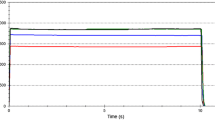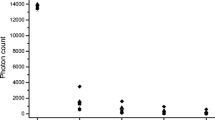Abstract
It is very important to characterize the crystalline and amorphous phases of resin composites because they are associated with the material’s mechanical behavior. Therefore, this study aimed to determine the inorganic elemental composition (by EDXRF), crystalline and amorphous phases, crystallinity index, crystallite size, average distance between scattering centers (by XRD) and morphology (by SEM) of three bulk-fill resin composites with different flowability submitted to different light-cure protocols. Samples (N = 3) of Tetric N-Ceram bulk-fill (TNC), Opus bulk-fill (OBF), and Filtek bulk-fill Flow (FBFF) resins were submitted to the following light-cure protocols: control (P0)—not irradiated; standard (P1)—irradiance of 1000 mW/cm2 for 20 s; and Xtra (P2)—irradiance of 3200 mW/cm2 for 6 s. The composite’s crystallinity showed to be dependent on the type of filler loads and not dependent of the light-cure protocol. The TNC and FBFF resins were identified as semi-crystalline materials, while OBF presented only an amorphous halo. Although the light-cure protocol did not influence the composite’s crystalline properties, the polymeric particles observed on composite’s surface presented smaller average particle size and were more homogeneous when samples were irradiated with higher potency (P2). Only YbF3 (found in TNC and FBFF) and ZrO2 (found in FBFF) compounds contribute to the crystalline phase of the BFRCs tested, besides being the only particles detected in the nanometric scale.




Similar content being viewed by others
References
Peutzfeldt A (1997) Resin composites in dentistry: the monomer systems. Eur J Oral Sci 105:97–116. https://doi.org/10.1111/j.1600-0722.1997.tb00188.x
Anusavice KJ, Shen C, Rawls HR (2013) Phillips, science of dental materials, 12° edn. Elsevier, Alpharetta
Ferracane JL (1995) Current trends in dental composites. Crit Rev Oral Biol Med 6:302–318. https://doi.org/10.1177/10454411950060040301
Hwang JJSPI (2015) Polymerization shrinkage and depth of cure of bulk-fill resin composites and highly filled flowable resin. Oper Dent 40:172–180. https://doi.org/10.2341/13-307-L
Miranda CB, Alves E, Campos DOS (2015) State of the art of bulk-fill resin-based composites: a review. Revista Facultad de Odontología Universidad de Antioquia 27:177–197
Bucuta S, Ilie N (2014) Light transmittance and micro-mechanical properties of bulk fill vs. conventional resin based composites. Clin Oral Investig 18:1991–2000. https://doi.org/10.1007/s00784-013-1177-y
Bresciani E, Caneppele TMF (2016) Resinas bulk-fill – O estado da arte. Revista da Associacao Paulista de Cirurgiões Dentistas 70:242–248
Chesterman J, Jowett A, Gallacher A (2017) Bulk-fill resin-based composite restorative materials: a review. Br Dent J 222:337–344. https://doi.org/10.1038/sj.bdj.2017.214
Junior SAR, Scherrer SS, Ferracane JL, Della Bona A (2008) Microstructural characterization and fracture behavior of a microhybrid and a nanofill composite. Dent Mater 24:1281–1288. https://doi.org/10.1016/j.dental.2008.02.006
Kim RJ, Kim Y, Choi N, Lee I (2015) Polymerization shrinkage, modulus, and shrinkage stress related to tooth-restoration interfacial debonding in bulk-fill composites. J Dent 43:430–439. https://doi.org/10.1016/j.jdent.2015.02.002
Li Y, Swartz ML, Phillips RW, Moore BK, Roberts TA (1985) Materials science effect of filler content and size on properties of composites. J Dent Res 64:1396–1403. https://doi.org/10.1177/00220345850640121501
Kim KH, Ong JL, Okuno O (2002) The effect of filler loading and morphology on the mechanical properties of contemporary composites. J Prosthet Dent 87:642–649. https://doi.org/10.1067/mpr.2002.125179
Fu SY, Feng XQ, Lauke B, Mai YW (2008) Effects of particle size, particle/matrix interface adhesion and particle loading on mechanical properties of particulate–polymer composites. Compos B Eng 39:933–961. https://doi.org/10.1016/j.compositesb.2008.01.002
Spahr DE, Schultz JM (1990) Determination of matrix crystallinity of composites by X-ray diffraction. Polym Compos 11:201–210. https://doi.org/10.1002/pc.750110402
Henrique P, Alpino PD, Vinı M, Frederico C, Graeff DO, Hortencia A, Gonza M (2014) Free radical entrapment and crystallinity of resin composites after accelerated aging as a function of the expiration date. J Mech Behav Biomed Mater 36:82–89. https://doi.org/10.1016/j.jmbbm.2014.04.009
Bush MA, Miller RG, Prutsman-Pfeiffer J, Bush PJ (2006) Identification through X-ray fluorescence analysis of dental restorative resin materials: a comprehensive study of noncremated, cremated, and processed-cremated individuals. J Forensic Sci 52:157–165. https://doi.org/10.1111/j.1556-4029.2006.00308.x
Kamalak H, Canan A, Altin S (2018) The mechanical properties of nanohybrid and bulk fill posterior composites. Biomed Res 29:2179–2186. https://doi.org/10.4066/biomedicalresearch.29-18-482
Stern P, Polymer ES (1968) On the structure of polypropylene fibres. Polymer 9:471–477. https://doi.org/10.1016/0032-3861(68)90057-8
Tzeng S, Chr Y (2002) Evolution of microstructure and properties of phenolic resin-based carbon/carbon composites during pyrolysis. Mater Chem Phys 73:162–169. https://doi.org/10.1016/S0254-0584(01)00358-3
Short M, Carbon PWJ (1963) Measurement of interlayer spacings and crystal sizes in turbostratic carbons. Carbon 1:3–9. https://doi.org/10.1016/0008-6223(63)90003-4
Collares FM, Ogliari FA, Lima GS, Fontanella VRC, Piva E, Samuel SMW (2010) Ytterbium trifluoride as a radiopaque agent for dental cements. Int Endod J 43:792–797. https://doi.org/10.1111/j.1365-2591.2010.01746.x
Soares C, Rosatto C, Carvalho V, Bicalho A, Henriques J, Faria-e-Silva A (2017) Radiopacity and porosity of bulk-fill and conventional composite posterior restorations—digital X-ray analysis. Oper Dent 42:616–625. https://doi.org/10.2341/16-146-L
Asaka Y, Miyazaki M, Aboshi H, Yoshida T, Takamizawa T, Kurokawa H, Rikuta A (2004) EDX fluorescence analysis and SEM observations of resin composites. J Oral Sci 46:143–148. https://doi.org/10.2334/josnusd.46.143
Oliveira TCS, Piva E, Leal FB, Moncks MD, Raubach CW (2012) YbF3/SiO2 fillers as radiopacifiers in a dental adhesive resin. Nano Micro Lett 4:189–196. https://doi.org/10.3786/nml.v4i3
Cardin D, Lappert M, Raston C (1986) Chemistry of organo-zirconium and -hafnium compounds. Ellis Horwood Ltd, USA
Mitra S, Wu D (2003) An application of nanotechnology in advanced dental materials. J Am Dent Assoc 134:1382–1390. https://doi.org/10.14219/jada.archive.2003.0054
Besegato J, Inocente E, Casanova A, Vignoto R, Martins F, Luiz B, Vicentin S (2019) Effect of light-curing protocols on the mechanical behavior of bulk-fill resin composites. J Mech Behav Biomed Mater 90:381–387. https://doi.org/10.1016/j.jmbbm.2018.10.026
Jaarda MJ, Lang BR, Wang RF, Edwards CA (1993) Measurement of composite resin filler particles by using scanning electron microscopy and digital imaging. J Prosthet Dent 69:416–424. https://doi.org/10.1016/0022-3913(93)90191-P
Reis AF, Giannini M, Ambrosano GMB, Chan DC (2003) The effects of filling techniques and a low-viscosity composite liner on bond strength to class II cavities. J Dent 31:59–66. https://doi.org/10.1016/S0300-5712(02)00122-7
Takanashi E, Kishikawa R, Ikeda M, Inai N, Otsuki M, Foxton RM, Tagami J (2008) Influence of abrasive particle size on surface properties of flowable composites. Dent Mater J 27:780–786. https://doi.org/10.4012/dmj.27.780
Fronza B, Ayres A, Pacheco R, Rueggeberg F, Dias C, Giannini M (2017) Characterization of inorganic filler content, mechanical properties, and light transmission of bulk-fill resin composites. Oper Dent 42:445–455. https://doi.org/10.2341/16-024-L
Soh MS, Yap AUJ (2004) Influence of curing modes on crosslink density in polymer structures. J Dent 32:321–326. https://doi.org/10.1016/j.jdent.2004.01.012
Sigemori R, Reis A, Giannini M, Paulillo L (2005) Curing depth of a resin-modified glass ionomer and two resin-based luting agents. Oper Dent 28:185–189
Burey A, dos Reis PJ, Santana Vicentin BL, Dezan Garbelini CC, Grama Hoeppner M, Appoloni CR (2018) Polymerization shrinkage and porosity profile of dual cure dental resin cements with different adhesion to dentin mechanisms. Microsc Res Tech 81:88–96. https://doi.org/10.1002/jemt.22960
Buelvas DDA, Besegato JF, Vicentin BLS, Jussiani EI, Hoeppner MG, Andrello AC, Di Mauro E (2020) Impact of light-cure protocols on the porosity and shrinkage of commercial bulk fill dental resin composites with different flowability. J Polym Res 27:1–10. https://doi.org/10.1007/s10965-020-02257-4
Furtos G, Baldea B, Silaghi-Dumitrescu L, Moldovan M, Prejmerean C, Nica L (2012) Influence of inorganic filler content on the radiopacity of dental resin cements. Dent Mater J 31:266–272. https://doi.org/10.4012/dmj.2011-225
Ermis RB, Yildirim D, Yildiz G, Gormez O (2014) Radiopacity evaluation of contemporary resin composites by digitization of images. Eur J Dent 8:342–347. https://doi.org/10.4103/1305-7456.137644
Author information
Authors and Affiliations
Corresponding author
Additional information
Publisher's Note
Springer Nature remains neutral with regard to jurisdictional claims in published maps and institutional affiliations.
Rights and permissions
About this article
Cite this article
Buelvas, D.D.A., Vicentin, B.L.S., Urbano, A. et al. Crystalline properties and morphology of bulk-fill dental resin composites as function of light-cure protocol and composition. Polym. Bull. 80, 2349–2366 (2023). https://doi.org/10.1007/s00289-022-04163-9
Received:
Revised:
Accepted:
Published:
Issue Date:
DOI: https://doi.org/10.1007/s00289-022-04163-9




